Cinema of the Great Patriotic War: the time of heroes and geniuses
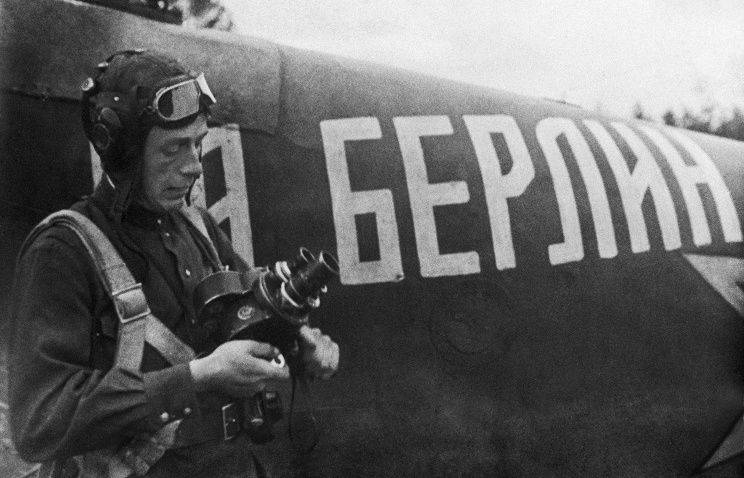
The Great Patriotic War was perhaps the most fruitful time for Soviet cinema. For four years, hundreds of gaming and documentary films, short films and, of course, a unique chronicle, according to which the modern generation remembers the terrible wartime, have appeared.
A shot from the movie "They Fought for the Motherland." In the photo: Yuri Nikulin as Nekrasov, Vasily Shukshin as Peter Lopakhin and Ivan Lapikov as foreman Poprishchenko (foreground from left to right)
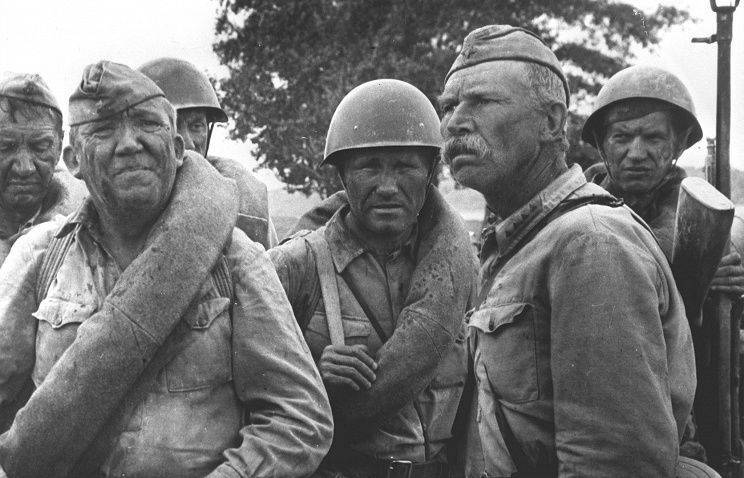
Veterans will be the main audience of the international film festival "Spirit of Fire" in Ugra
The ideological power of cinema was well recognized both by the Soviet authorities and by the filmmakers themselves, who understood that it was necessary not only to inform the people about what was happening at the front, but also to inspire victory. The period of comedies 1930-s reminded of itself except that the favorite movie characters, who turned to the audience from the screens. The problematics and aesthetics of military paintings have changed significantly compared with peacetime. However, many historians recognize that the cinema of the war years was one of the freest in all history Soviet cinema. He gave the country and the world such masterpieces as Mark Don Donskoy’s Rainbow, Leonid Varlamov and Ilya Kopalin’s “Defeat of the German Forces near Moscow”, “Ivan Pyryev at the 6 hours after the war,” Alexander Stolper’s “Wait for Me”, “Two Fighters” Leonid Lukov, "Ivan the Terrible" Sergei Eisenstein and many other films that are included in the history of domestic and foreign cinema. Work on all these films was carried out in the most difficult conditions, the Central United Film Studio of Feature Films in Almaty, with which most of the history of military cinema is associated, became a new home for almost all iconic filmmakers of that time.
Documentary chronicle and the first Oscar
As soon as the war began, cameramen immediately went to the front, thanks to which the people of that time, and subsequent generations, could have reliable information about the course of hostilities. As well-known film expert Ney Vigilant writes in his book The History of Russian Cinema of the 20th Century, 250 cameramen participated in the war, every fifth of whom died.
"The combat newsreel squadron was the most responsible. The documentary studio immediately got involved in the war: there were many front-line groups, front-line operators who were shooting on the front line. Many died in this shoot. And the fact that we see a true chronicle of the war is bought with blood, price many lives, "- says the historian of cinema Naum Kleiman.
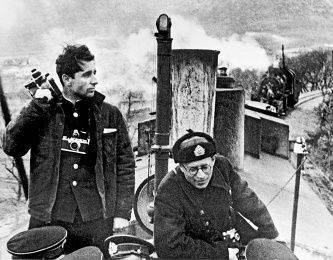
© Photo Chronicle TASS
He notes that in addition to directly those who filmed at the front, documentary brigades were actively working in Moscow.
"On the square of the Kiev station there was a studio" Soyuzkinohronika "where round-the-clock duty was carried out. People received a film from the front, immediately showed, immediately mounted. It was all, of course, that the material was checked upwards, where they checked the material. Everyone understood that it was fighting the cinema and thus "That is, it raises the spirit of the people. They gave a picture of the battles, and, as a rule, in the early years of the war they were very tragic shootings," emphasizes Kleiman.
One of the most vivid documentary evidence of that era was the film “The rout of the German troops near Moscow” by Ilya Kopalin and Leonid Varlamov, made at the Central studio of newsreels based on 15 front-line filming. As Kopalin recalled, the film was mounted day and night, "in cold assembly rooms, without going to the shelter, even with air-raids."
"At the end of December 1941, the montage of the painting was completed. In the huge cold pavilion of the studio, dubbing began. The most important and exciting record came: Tchaikovsky's Fifth Symphony. Light Russian melody, angry protest, sobbing chords. , and all the way the fascist retreats traces of violence and barbarism. We listened to music, looked at the screen and wept. The orchestra cried, playing with frozen hands with difficulty, "the director wrote in his memoirs.
The picture came out on screens in 1942 year and was awarded the Stalin Prize.
"It was an important work, because it showed both the feat and the sufferings of the people. They showed not only the fighting, but also the suffering of the people — the occupation and the guerrilla executions — all this was actually shown for the first time in this picture "- says Kleiman.
The film "The defeat of the German troops near Moscow" came out and rolled into an American film called "Moscow Strikes Back." In it, the audience first saw the terrible events of the war and the inhumanity of the Nazis. The picture of Kopalin and Varlamov shook American viewers and cinematographers so much that in 1943, she won the Oscar for best documentary. It was the first award from the American Film Academy in the history of Russian cinema.
Battle film collectors and Lensky's aria
In the game cinema, the first wartime testimonies were the battle movie collectors - the so-called BCS. They went under the motto "The enemy will be defeated, victory will be ours!" and consisted of several parts. The issue included news from the front, essays, satirical short films and musical numbers. The first film collection came out almost a month after the start of the war - August 2 1941. The script for him was written by Grigory Kozintsev and Leonid Trauberg, and was shot by a team of directors headed by Sergey Gerasimov. One of the episodes of this collection was the short story "Meeting with Maxim", where young worker Maxim, who was beloved by many in 30, performed by Boris Chirkov appealed to viewers to go to the front.
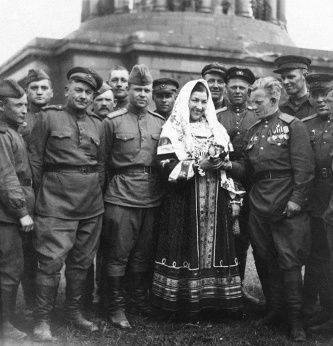
© Photo Chronicle TASS
"Literally, from the first months of the war, they began to shoot the BCS - combat film collectors from short films that immediately went to the front. And their favorite characters from 30's were attracted to their shootings. Chapaev, who carried the Red Army soldiers against the fascists with him, or Max. old footage from the film "Maxim's Youth" with new shootings of Chirkov, who directed the soldiers to battle. It worked amazingly. They shot concert films. All the popular actors for the front sang and danced - Ruslanova, who was adored by everyone, Ulanova, Lemeshev. everything by the way was kind weapons. Because, for example, Lemeshev’s aria of Lensky was inspired by people no less than “Get up a huge country” because people understood what they were protecting, ”says Naum Kleiman.
Short films for BCS filmed the entire color of cinema - from Grigory Alexandrov and Boris Barnet to Leonid Trauberg and Grigory Kozintsev.
“Badayev food warehouses were burning in Leningrad, bombing began, and we composed and shot for the front. One thing was important: the screen, hung in a dugout on two ramrod stuck between logs, had to fight,” Kozintsev recalled.
Critics noted that not all short films were successful from an artistic point of view, but it was impossible not to evaluate their contribution to raising the morale of the soldiers.
"Laureate" protects the Motherland
The work on the combat film collectors was also carried out when the filmmakers were sent into evacuation to the Central United Film Studio created in Almaty.
"In November, an order was issued on 1941, since the blockade had already begun, and Mosfilm and Lenfilm were transported to Alma-Ata. The cultural center and hotel were allocated for them. And this two-story house was a few years ago, I saw it still stood, there were memorial plaques on it, but there were no windows, it was resettled. This house was called a laureate. The leading directors lived there - from Eisenstein to the Vasilyev brothers. The building where the philharmonic is now located was turned into a pavilion ", - tells the film historian, Lenfilm studio editor Alexander Pozdnyakov.
For example, Grigory Kozintsev in Almaty made a satirical short film "Young Fritz", based on the script of Samuel Marshak.
“Kozintsev became known to everyone after Hamlet, and at TsOKS he made the painting“ One Night ”and the film“ Young Fritz ”- so short, satirical. The operator was Andrei Moskvin, the artist - Yevgeny Yenay, the composer - Lev Schwartz, Ilya Volkov - the sound engineer. In other words, these were the best people who worked with Kozintsev on this short film, which was, according to Marshak's poem, about bringing up a real fascist - such a satire, eccentric, in the film. “Such a brilliant actor. So, Kozintsev, before removing his epic pictures on Lenfilm, he made such short half-hour films at TsOKS,” Pozdnyakov stresses.
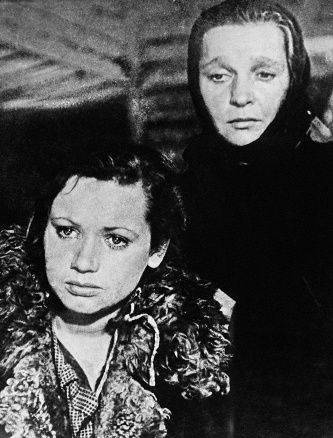
© Photo Chronicle TASS
The first feature film about military events was the tape of Ivan Pyryev "Secretary of the District Committee", shot in 1942 year and then received the Stalin Prize. Work on TsOKS went without stopping. In the most difficult evacuation conditions, filmmakers created more and more new pictures.
“She has defended Friedrich Ermler’s film on TsOKS. The Central Russian landscapes shown in it were filmed in Trans-Ili Alatau. A wonderful actress Vera Maretskaya plays the main role in the film. It was such a tragic, epic picture that it impressed the audience with of the whole world, "says Pozdnyakov.
According to the memoirs of the actress Vera Maretskaya, on the last day of the shooting of the film “She Protects the Motherland”, she received a funeral for her husband, actor George Trinity, who died at the front.
Wartime themes
Among other paintings of the time, Pozdnyakov also notes the tapes “Front” of the Vasilyev brothers, “Air carrier” by Herbert Rappaport and “Actress” by Leonid Trauberg.
"The best picture made by Lenfilm on TsOKS was, in my opinion, Traubert's Actress. The script for her was written by Mikhail Volpin and Nikolai Erdman. Galina Sergeeva and Boris Butterflies were shot there. He is a blind, wounded major, she is operetta actress, evacuated outside the Urals. People just wept. The picture helped, inspired, saved people, "says Pozdnyakov.
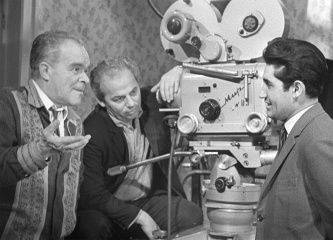
© Photo Chronicle TASS
Work on the creation of films was, however, not only in Almaty. For example, the Kiev Film Studio was evacuated to Ashgabat. It was there that one of the masterpieces of wartime was shot - the film “Rainbow” by Mark Donskoy, whose main character, Olyona Kostyuk, was becoming a partisan.
"The frozen winter Ukrainian village was recreated in the forty-degree heat in the Turkmen desert with the help of artificial snow, naphthalene, glass icicles, which the local factory specifically blew," writes Neya Zorkaya.
The premiere of this film took place in January 24 1944. The tape received the main prize of the association of film critics of the United States.
“In wartime, such genres suddenly appeared that were not very encouraged in 30's. For example, the“ Wait for me ”melodrama is about love and loyalty. It was important for the fighters to understand that their wives were waiting in the rear. A song was created based on Simonov’s verses , the film was played by his beloved woman Valentina Serova. The painting "Wait for me" was unusually popular. Next to her, of course, there were pictures about the sufferings of the people: for example, "Rainbow" is a wonderful film by Mark Donskoy, and films about partisans like " Secretary of the District Committee "Pyr'ev, and his own" In the 6 hours of the evening after the war "-" F and me. "In another embodiment, all filmed and about the front, rear, and about the same time, to let people know that they protect the front and rear of the people in the know who protects them." - says Naum Kleiman.
Neya Zorkaya also emphasized that "suffering, pain, separation, loss, tears, hunger, fear - all of this, expelled from the screen in 1930's, was forced to legalize the war."
Kleiman also notes that this, of course, was idealized cinematography, but it was required at that moment and was justified.
“Finally, a soldier came to the fore and only at the end of the war, when we began to win the Germans, images of commanders suddenly appeared, Stalin appeared,” Kleiman notes.
"Alexander Nevsky" - at the front, "Ivan the Terrible" - in the rear
The central film studio has become a place of filming for the most ambitious film of Sergei Eisenstein "Ivan the Terrible". As Naum Kleiman says, at the beginning of the war, Eisenstein wanted to shoot short films for combat film collectors and read lectures on drama of the short script, directing VGIK students to use not only modern subjects, but also classical literature in their short films. In particular, Eisenstein advised director Michael Schweitzer to remove the episodes from War and Peace, saying that "Tolstoy is as much a fighter as our new writers."
“But in 1942, Stalin’s order came to continue Ivan the Terrible, which Eisenstein had begun even before the war. Stalin was interested in making the film, he certainly could not have imagined that Eisenstein would accuse the autocracy, and thought it would be something like "Alexander Nevsky," - says film expert.
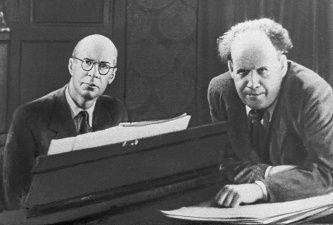
© Reproduction of TASS photochronicles.
He stresses that the film, which was released in 1938 year and essentially warned about the war, was removed from the rental after signing the Molotov-Ribbentrop Pact and was not shown until 1941.
“But as soon as the message about the attack of fascist Germany was sounded, the first thing that was broadcast on the radio was a song from Alexander Nevsky,“ Get up, people, Russian! ”, Which was later written on“ Get up, the country is huge. ”There is almost a textual coincidence. That is, "Alexander Nevsky" fought at the front all the 5 years, and he always took part in it in absentia, and Eisenstein at this time was shooting "Ivan the Terrible", says Kleiman.
Film expert calls the film "Ivan the Terrible" the most luxurious picture of Eisenstein. Given that it was made in extremely difficult conditions.
“There was no money, the film crew managed to make the Kremlin, the Assumption Cathedral, the Tsar's Chambers from the House of Culture in an absolutely incredible way. It was all built of plywood. The group worked almost at night because there was no electricity during the day — it went to military factories. At night when energy was released a little, it was given to the film studio, "the film expert notes.
The filming pavilions were not heated, and the actors were forced to wear extra clothes under the costumes.
"Sometimes in the frame it is clear that steam comes from the actors' mouths, because it was cold in the pavilion, nothing was heated. And the actors under these boyar garments wore thicknesses to keep warm. And only Nikolai Cherkasov with incredible effort of will in his royal shirts was shot without these But they all had an incredible inspiration, because everyone understood that it was part of Russian culture. They understood that the fascists wanted to conquer not only the people, the wealth of Russia, but also want to destroy the culture. This picture, which mobilized all pass our culture ", - says Kleiman.
He emphasizes that "Eisenstein created the film in the tradition of" Boris Godunov "and Pushkin, and Mussorgsky," "first introduced iconographic traditions in our cinema and reflected in the visual structure of the film." The music for Ivan the Terrible was written by Sergei Prokofiev, the operators were Edward Tisse and Andrei Moskvin.
“We can say that this is a film of geniuses. And we proved during the war that we can make cinema no worse than Hollywood. In a sense, we can say that Ivan the Terrible is also a kind of military feat,” the film expert notes.
Losses and gains
A feat, however, can be considered all the films created in wartime conditions.
"It must be imagined that it was when the actors who worked in the theaters - say, St. Petersburg actors from the Pushkin Theater, who was evacuated to Novosibirsk, - traveled at night after the performance to shoot in Alma-Ata, came for a few days, but then they returned to play theater. The tension was colossal. But the film industry was not interrupted for a month during the war. The cinema and in the rear was the same front, "says Kleiman.
He says that, for example, the actress Lidia Smirnova recalled that in the morning she was making herself a “bump” (a small amount of water was added to a small amount of cereal), said that it was necessary so that she wouldn’t rumble from the hunger in the stomach, there was no sound during filming. "
Not all filmmakers agreed to evacuate, but many understood that this was how they performed their duty to their homeland.
“For Lenfilm, it was, of course, a forced evacuation, but it allowed all directors to remain in the ranks, their professionalism was developing. There were the best of the best. But not everyone agreed to evacuate. Yevgeny Chervyakov worked at Lenfilm - he volunteered for the front and died in the 1942 year. He was one of the brightest directors of our studio, "says Alexander Pozdnyakov.
Naum Kleiman also notes that many young guys were rushing to the front.
“For example, Eisenstein had two beloved students on the course, who graduated in 1936, and he had great hope for wonderful young directors Valentin Kadochnikov and Oleg Pavlenko. Valentin Kadochnikov had a sore heart, he was mobilized to the labor front, to prepare saxaul - wood for heating, and he died at these developments, his heart could not stand it. And Oleg Pavlenko went into the army and burned down in tank in 1942. These were the two closest and dearest students to Eisenstein, and for him it was a terrible tragedy, "the film expert notes.
Evacuation was a salvation for many Soviet filmmakers and, of course, the basis for the further development of cinema.
"Suddenly, after that, Kazakh cinema, Turkmen cinema, Tajik cinema. It was an impulse for local people to do cinema. They worked as assistants, props, they studied on the move. There remained equipment in many cases, some experts remained and wonderful films appeared after the war is already local cinematography ", - says Kleiman.
Alexander Pozdnyakov also emphasizes the influence of the joint film studio on the development of Kazakh cinematography.
“At TsOKS, in particular, they shot the film“ To the sounds of the domr. ”One of the directors was the Lenfilm comedian Semen Timoshenko. There are different genres of Kazakh art, the master of the Kazakh theater. This is how Rustam Khamdamov later shot Vocal Parallels Kazakh opera singers are a brilliant movie. It was a time when evacuees shared the last and were inspired to communicate with each other, "Pozdnyakov said.
Information